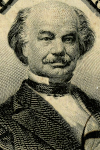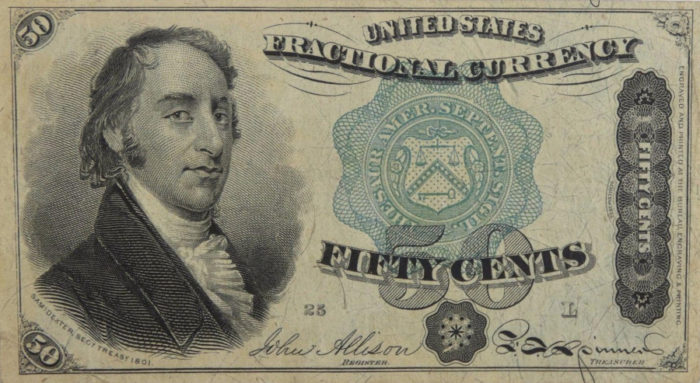
Over the last few weeks, we have looked at the life of Beau Hickman as told in a book written by his cousin shortly after his death. Much of the book on Beau Hickman is taken up by different anecdotes of Hickman’s life, whether how he scammed a round of drinks out of a bar, or how his attempts to act as a lawyer were thwarted (though he later convinced the judge to pay up his fees) or how he managed to get free passage on the train by claiming to have lost his ticket along with his hat out the window of the carriage when prodded by the conductor to produce proof of his having paid.
Most of these tales live entirely in the pages of the book, with no possibility of determining their veracity at this late date. One of them, however, had real-world implications which can be examined even now.
Under the title “A Joke” is the following story:
It is said that when the fifty cent stamp was shown to Treasurer Spinner he detected the striking resemblance of the vignette to Beau Hickman, and to obviate any mistake he had engraved under the likeness: Samuel Dexter, Secretary of the Treasury. Beau is is said to have insisted the joke was rather fine, and that it reminded him of the school boy who drew on his slate what was intended to resemble the picture of a horse, and wrote under the drawing: “This is a horse.”
With the outbreak of the Civil War, citizens began hoarding coins for their value as metal. To ensure that commerce could continue, the Department of the Treasury, under guidance of Secretary Francis E. Spinner (pictured) began printing bills of smaller denominations than a dollar. These bills were referred to as fractional currency, and were printed until 1876.
While earlier issues featured mainly pictures of George Washington, they later branched out, and so the fourth series, which was was released on July 14, 1869, had pictures Columbia, Washington, Lincoln, Edwin Stanton…and Samuel Dexter. The last differed from all previous bills issued in that there was text identifying the subject: “Sam’l Dexter, Secy Treasy 1801”

Whether this was done to make it clear that it was not Hickman shown we will never know. However, the last series of fractional currencies, which was released five years later, all of the vignettes are thus labeled. Dexter was also the first whose face would most likely have been unknown to the general public. His time in the limelight – during which he was, in turn, a representative, senator, secretary of war and secretary of the treasury – extended only from 1793 to 1801, and had died in 1816, so he was hardly a household name fifty years later.
Either way, the idea that it was deemed necessary to add the name below a picture of an historic statesmen for fear that it would be taken for a local bummer instead is certainly an amusing one, and it will be this amusement that we will have to content ourselves with light of the fact that the true story will most likely never be known.
